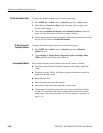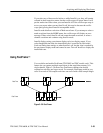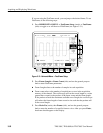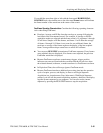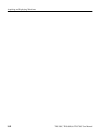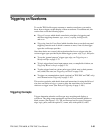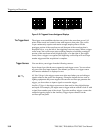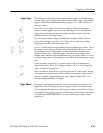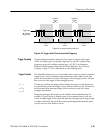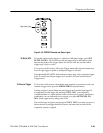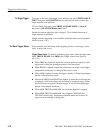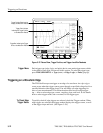
Triggering on Waveforms
3–66
TDS 500C, TDS 600B, & TDS 700C User Manual
Automatic trigger mode (auto mode) enables the oscilloscope to acquire a
waveform even if a trigger does not occur. Auto mode uses a timer that starts
after a trigger event occurs. If another trigger event is not detected before the
timer times out, the oscilloscope forces a trigger anyway. The length of time it
waits for a trigger event depends on the time base setting.
Be aware that auto mode, when forcing triggers in the absence of valid triggering
events, does not sync the waveform on the display. In other words, successive
acquisitions will not be triggered at the same point on the waveform; therefore,
the waveform will appear to roll across the screen. Of course, if valid triggers
occur the display will become stable on screen.
Since auto mode will force a trigger in the absence of one, auto mode is useful in
observing signals where you are only concerned with monitoring amplitude
level. Although the unsynced waveform may “roll” across the display, it will not
freeze as it would in normal trigger mode. Monitoring of a power supply output
is an example of such an application.
When the oscilloscope recognizes a trigger event, it disables the trigger system
until acquisition is complete. In addition, the trigger system remains disabled
during the holdoff period that follows each acquisition. You can set holdoff time
to help ensure a stable display.
For example, the trigger signal can be a complex waveform with many possible
trigger points on it. Though the waveform is repetitive, a simple trigger might
get you a series of patterns on the screen instead of the same pattern each time.
A digital pulse train is a good example of a complex waveform. (See Fig-
ure 3–33.) Each pulse looks like any other, so many possible trigger points exist.
Not all of these will result in the same display. The holdoff period allows the
oscilloscope to trigger on the correct edge, resulting in a stable display.
Holdoff is settable from 250 ns (minimum holdoff available) to 12 seconds
(maximum holdoff available). To see how to set holdoff, see To Set Mode &
Holdoff on page 3–75.
You can also set a default holdoff. The default hold is the “general purpose”
holdoff for most triggering signals and varies with the horizontal scale. It is
equal to 5 divisions times the current time/division settings.
Trigger Holdoff



